Orthogonal frequency division multiplexing (OFDM) is a multicarrier modulation technique with high bandwidth efficiency, high transmission rate, and robustness to multipath fading. It has been adopted in wireline applications such as digital audio broadcasting (DAB)[1], underwater acoustic communication (UWA)[2], and digital video broadcasting (DVB)[3], fifth generation (5G)[4], etc.
Channel estimation is essential for OFDM systems; the influence of the channel needs to be estimated at the receiver. Pilot-based approaches are widely used in channel estimation. Pilot tones can be inserted into the time domain or frequency domain, called block-type and comb-type. The comb-type pilot arrangement has better performance than the block-type for fast-fading channels[5]. The estimated channel frequency response (CFR) at the pilot positions can be obtained by least square (LS) or minimum mean square error (MMSE)[6]. MMSE algorithm provides better performance with high complexity. LS algorithm utilizes the least-squares criterion and has been widely used due to its low complexity.
The LS estimated CFR is interpolated to obtain CFR at all subcarriers. The interpolation methods can be divided into frequency domain interpolation, transform domain interpolation, and time domain interpolation. The frequency domain interpolation methods include linear interpolation, Gaussian interpolation, and spline cubic interpolation[7]. Transform domain interpolation uses the discrete Fourier transform (DFT) to transform the LS estimated CFR into the transform domain. High-resolution interpolation with low complexity is based on zero-padding in the transform domain and inverse DFT (IDFT)[8].
Time domain interpolation has a similar process to transform domain interpolation. The LS estimated CFR is transformed into the time domain by IDFT, and the estimated channel impulse response (CIR) is obtained. CFR at all subcarriers is obtained by zero padding and DFT. Time domain interpolation has been proven to have a lower bit error rate (BER) than linear interpolation[7]. Time domain interpolation has a better performance than transform domain interpolation, as shown in Ref.[8]. Furthermore, as demonstrated in Ref.[9], time domain interpolation outperforms linear, cubic, and low pass interpolation. Time domain interpolation has been investigated for OFDM systems with virtual subcarriers in Refs.[10, 11].
Time domain interpolation is accurate if the channel delays are integral multiples of the sample time of the OFDM symbol and the sample length of CIR is less than the number of pilots[12]. Furthermore, DFT and IDFT are easy to realize using the fast Fourier transform (FFT) algorithm[13]. Thus, time domain interpolation is widely used. Noise has the potential to affect LS, and noise reduction in the time domain is widely used[14-16]. Time domain interpolation is realized by zero-padding in the time domain. Therefore, it can be used with various time domain noise reduction methods.
However, pilot subcarrier spacing is determined by the channel’s maximum excess delay[11]. The pilot subcarriers used in channel estimation will consume a significant amount of subcarrier resources for the channel with a large delay spread[17]. To use time domain interpolation, the number of subcarriers must be an integral multiple of the pilot subcarrier spacing[18], which may cause a larger consumption of pilots. A reasonable pilot spacing should ensure good channel estimation performance while minimizing the number of subcarriers consumed by the pilots[19]. The subcarriers’ distribution is essential, especially for applications with narrow channel bandwidth[20-21].
In this paper,the modified time domain interpolation method is proposed to address the disadvantage of time domain interpolation in which the number of subcarriers must be an integral multiple of the pilot subcarrier spacing. Firstly, the OFDM system model is presented and the relationship between the estimated CIR from LS based on linear interpolation and the actual CIR is analyzed. Secondly, the disadvantages of time domain interpolation are examined and a modified time domain interpolation method is proposed. Then, simulation results are presented and analyzed.
1 Analysis of LS Channel Estimation Based on Linear Interpolation
1.1 System model
We consider an OFDM system that has N subcarriers. The transmitted signal at each subcarrier is {X[k], k=0, 1, …, N-1}, where k represents the subcarrier index. The transmitted signal is transformed to a discrete-time domain by IDFT, given by
(1)
where n is the sample index of the OFDM signal in the time domain. This is the modulation process of the OFDM system. Considering the effect of multipath effects, discrete-time CIR is given by
(2)
where l is the index of the different paths; αl is the path complex gain of the l-th path; τl is the delay of the l-th path; and L is the total number of channel paths. If reasonable CP guard samples are used after passing through a multipath channel and removing CP, the received OFDM signal is represented by
r[n]=x[n]⊗h[n]+z[n]
(3)
where ⊗ denotes an N-point circular convolution operation, and z[n] denotes time domain samples of independent and identical distributed additive white Gaussian noise (AWGN). Assuming perfect synchronization, the k-th subcarrier symbol in the frequency domain is given by
R[k]=DFTN{r[n]}=X[k]H[k]+Z[k]
(4)
where Z[k] are AWGN samples in frequency domain. Z[k]=DFTN{z[n]}, H[k]=DFTN{h[n]}, and DFTN{} represents N-point DFT.
By inserting pilot tones at some subcarriers,CFR at pilot positions can be obtained by
(5)
This method is called LS estimation.
1.2 Analysis of linear interpolation
We consider LS estimation using comb-type pilots and linear interpolation. Pilot tones are uniformly inserted at an m interval. When N/m is an integer and the first pilot tone is inserted at the first subcarrier, the number of pilots K=N/m. The estimated CFR at pilot positions is ![]() is defined as
is defined as
(6)
Defining ![]() i=0, 1, …, K}, by linear interpolation, the CFR at all subcarriers positions is given as
i=0, 1, …, K}, by linear interpolation, the CFR at all subcarriers positions is given as
![]()
p=0,1,…,m-1; k=0,1,…,N-1; i=0,1…,K-1
(7)
Further, the estimated CIR ![]() can be expressed by the N-point FFT of the estimated CFR, given by
can be expressed by the N-point FFT of the estimated CFR, given by
(8)
where WN=exp(-j2π/N), called the rotation factor. By the properties of the rotation factor[22], we have
(9)
when 0≤n≤K-1,
![]()
![]()
(10)
By Eqs.(9) and (10), we have
(11)
where PN,m[n] is defined by
(12)
The condition that N/m is not an integer is then considered, and the other conditions are the same. The number of pilots K= <N/m>, where <N/m> represents the nearest integer with a value greater than N/m.
As in Eq.(6), ![]() is defined by
is defined by
(13)
![]() k=0, 1, …, mK-1} is obtained by linear interpolation. Assuming mK/N≈1 and WN≈WmK, by similar deduction to Eqs.(8) to (12),
k=0, 1, …, mK-1} is obtained by linear interpolation. Assuming mK/N≈1 and WN≈WmK, by similar deduction to Eqs.(8) to (12), ![]() is represented by
is represented by
(14)
When N is large, the last two parts of Eq.(14) are insignificant. Then we have
(15)
2 Proposed Interpolation Method
2.1 Analysis of time domain interpolation
Time domain interpolation outperforms linear interpolation with low complexity in bit error rate (BER). It is realized by zero-padding and FFT/IFFT. The LS estimated CFR ![]() i=0, 1, …, K-1} is converted into the time domain by IFFT:
i=0, 1, …, K-1} is converted into the time domain by IFFT:
(16)
The K-sample time domain sequence ![]() by (N-K)-point zero-padding. There are two basic methods of zero-padding: The first one is padding at the end of the sequence[8], given by
by (N-K)-point zero-padding. There are two basic methods of zero-padding: The first one is padding at the end of the sequence[8], given by
(17)
The second one is padding at the middle of the sequence[23], given by

(18)
The first one is studied in this paper.
The estimated CFR at all subcarriers is obtained by N-point FFT:
(19)
To analyze the interpolation method separately, the LS estimated CFR is assumed to be accurate, i.e., ![]() Considering the condition that the delay τl in Eq.(2) is an integer, and the maximum delay τm≤K, then
Considering the condition that the delay τl in Eq.(2) is an integer, and the maximum delay τm≤K, then ![]() 0≤n≤K-1} is the accurate estimated result of CIR[12], proved as follows:
0≤n≤K-1} is the accurate estimated result of CIR[12], proved as follows:
(20)
(21)
As a result, time domain interpolation is a high-resolution method that is easy to realize. However, the number of subcarriers N must be the integral multiple of the pilot spacing m to use time domain interpolation, i.e., N/m must be an integer. m is determined by the maximum delay τm. The maximum pilot spacing that satisfies τm≤K does not always satisfy the requirement of time domain interpolation. Smaller pilot spacing can be designed to satisfy both requirements, but it increases the number of pilot subcarriers and reduces system efficiency. To overcome the limitation of time domain interpolation, the modified time domain interpolation method is proposed.
2.2 Modified time domain interpolation
Considering the condition that N/m is not an integer, the first pilot tone is inserted at the first subcarrier, and the number of pilots K=<N/m>. Assuming ![]() then we have
then we have
(22)
Assuming mK/N≈1 and WN≈WmK, similarly to Eqs.(20) and (21), we have
(23)
The relationship between CIR h[n] and the estimated CIR based on linear interpolation ![]() is derived from Eqs. (15) and (23) as follows:
is derived from Eqs. (15) and (23) as follows:
(24)
PmK,m[n] is close to 0 when n is close to K, as shown in Fig. 1.
In Eq.(15), I[n] in Eq.(14) is ignored. The error of Eq.(15) is given by
(25)
The smaller the value of PmK,m[n], the greater the error caused by simplification in Eq.(15), and the error becomes significant when n is close to K. Thus, considering the accuracy of calculation and ease of implementation, the last quarter of PmK,m[n] with a smaller value is discarded, and the approximate calculation results of
h[n] are as follows:

(26)
where <![]() > is the nearest integer with a value greater than
> is the nearest integer with a value greater than ![]() The estimated CFR at all subcarriers is obtained by the N-point FFT, given by
The estimated CFR at all subcarriers is obtained by the N-point FFT, given by
(27)
The calculation process of the proposed method is shown in Fig. 2.
3 Simulation Results and Discussion
3.1 Description of simulation
In this section, we analyze the performance of the proposed method on multipath channels. The OFDM system has 1 024 subcarriers and is modulated with 16-QAM. To
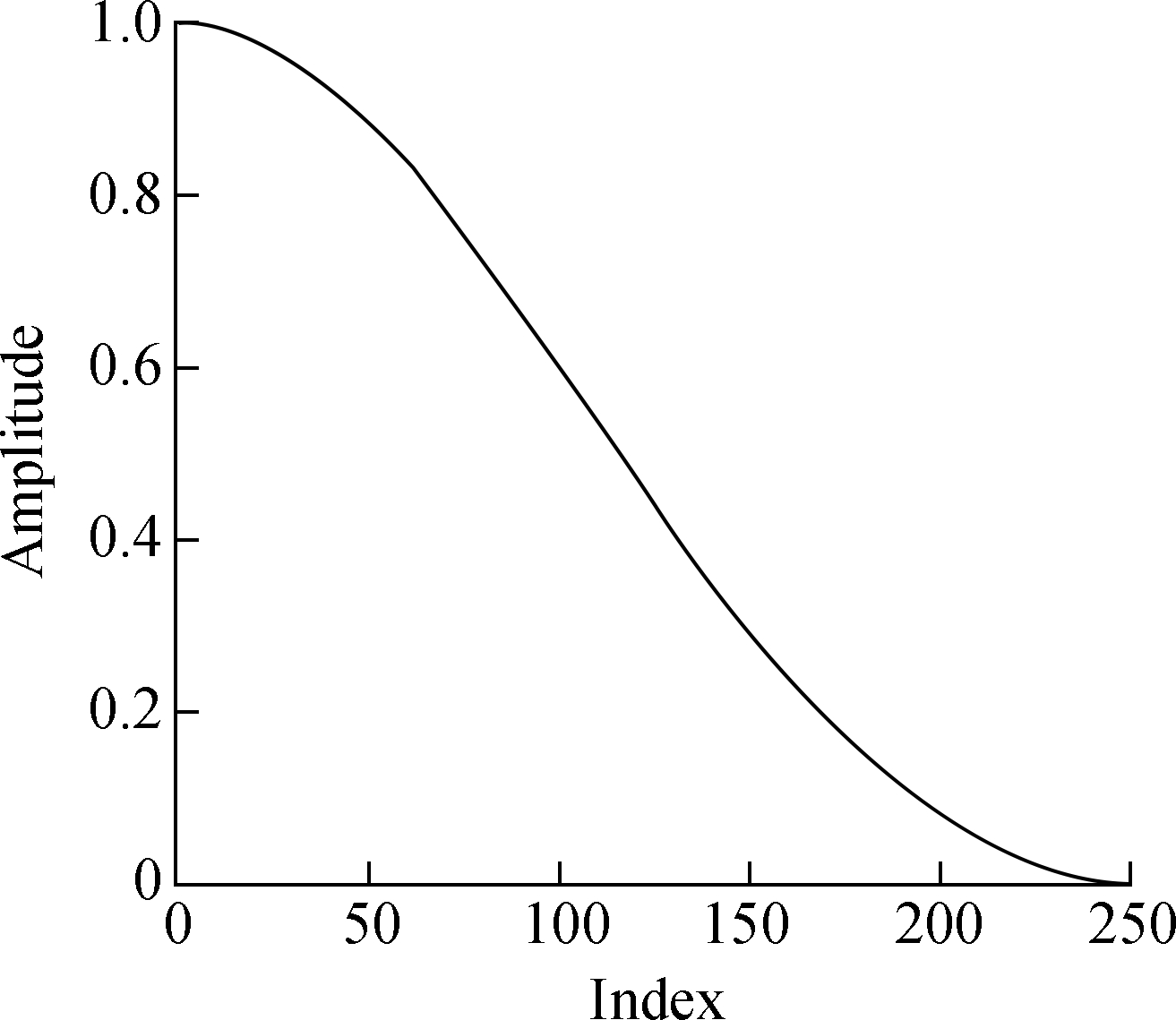
(a)

(b)
Fig.1 The value of PmK,m[n] against index n.(a) m=4, K=256; (b) m=5, K=205
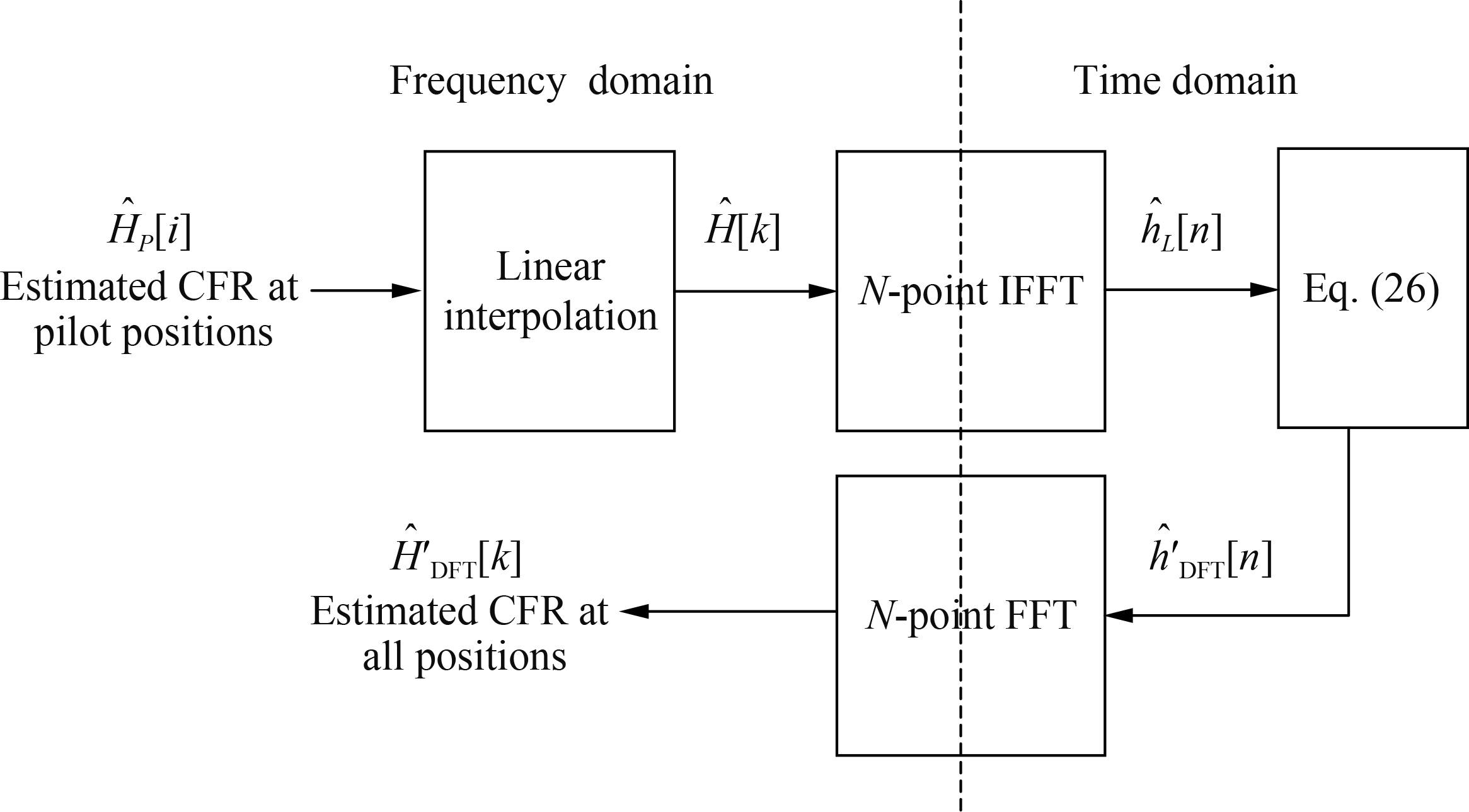
Fig.2 Calculation process of the proposed method
investigate the performance of the proposed method separately, the synchronization is assumed to be perfect.
The channel is the Advanced Television Technology Center and the Grand Alliance DTV Laboratory’s ensemble E model[16], and CIR for the static case is given by
h[n]=δ[n]+0.316 2δ[n-2]+0.199 5δ[n-17]+
0.129 6δ[n-36]+0.1δ[n-75]+0.1δ[n-137]
(28)
The unit delay is assumed to be the same as the sample period; there are no power losses caused by the non-spaced sample[24].
For the channel with static CIR given in Eq. (28), the BER and mean square error (MSE) of ![]() k=0, 1,…, 1 023} at different signal noise ratios (SNR) are examined. The BER is obtained after the received data has been decoded as binary data. The initial data is binary data generated at random, and the number of simulations is 100. The LS estimations are compared based on comb-type pilots with different pilot spacings and interpolation methods.
k=0, 1,…, 1 023} at different signal noise ratios (SNR) are examined. The BER is obtained after the received data has been decoded as binary data. The initial data is binary data generated at random, and the number of simulations is 100. The LS estimations are compared based on comb-type pilots with different pilot spacings and interpolation methods.
3.2 Comparison with common interpolation methods
Figs. 3 and 4 show the BER and MSE performance of various interpolation methods against SNR. The legends “linear, cubic, spline, and proposed method” denote LS channel estimation based on comb-type pilots with linear interpolation, cubic interpolation, cubic spline interpolation, and modified time domain interpolation.
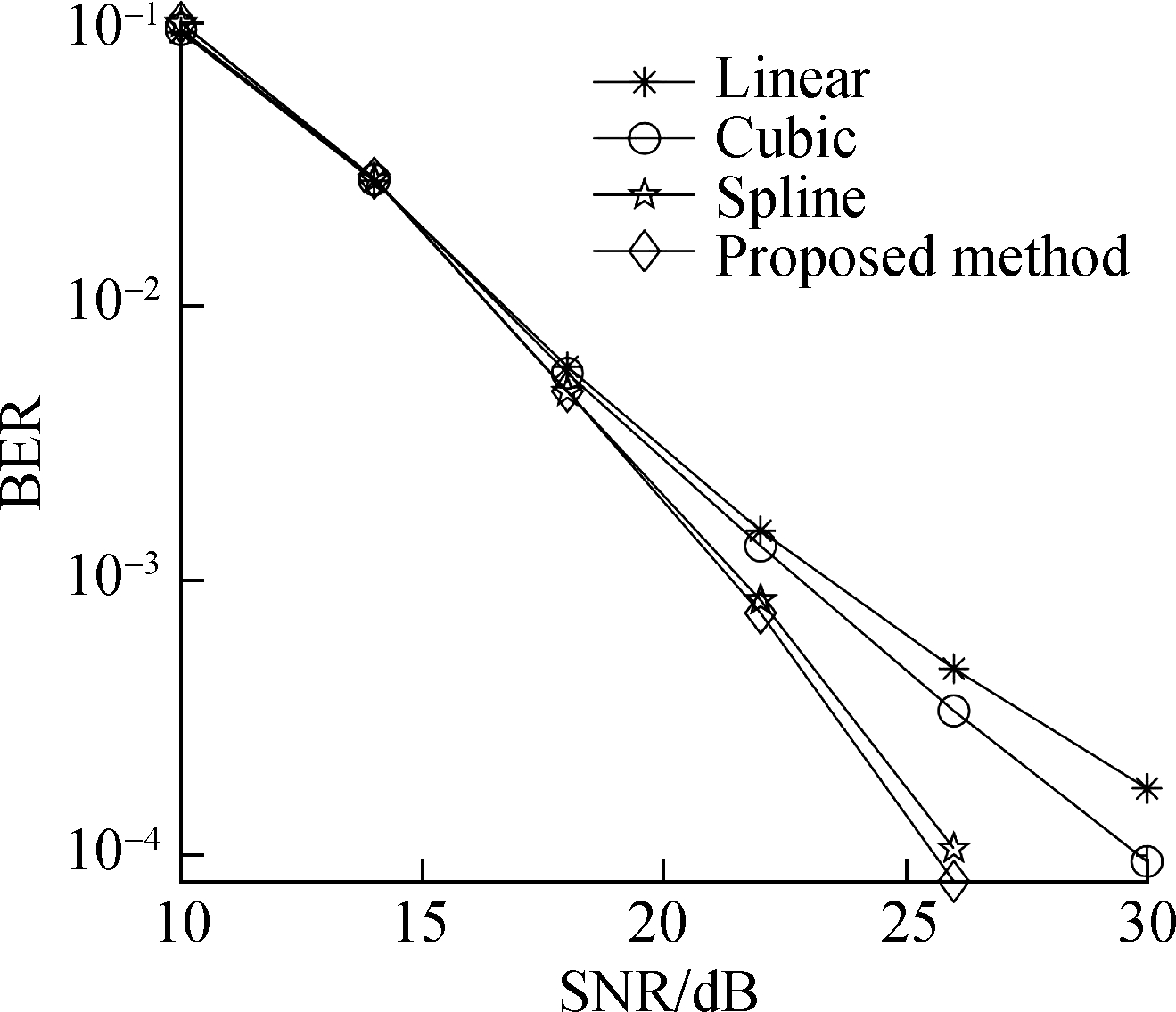
(a)

(b)
Fig.3 Comparing BER and MSE performance of linear, cubic, and cubic spline interpolation methods and the proposed method against SNR (m=3). (a) BER; (b) MSE

(a)
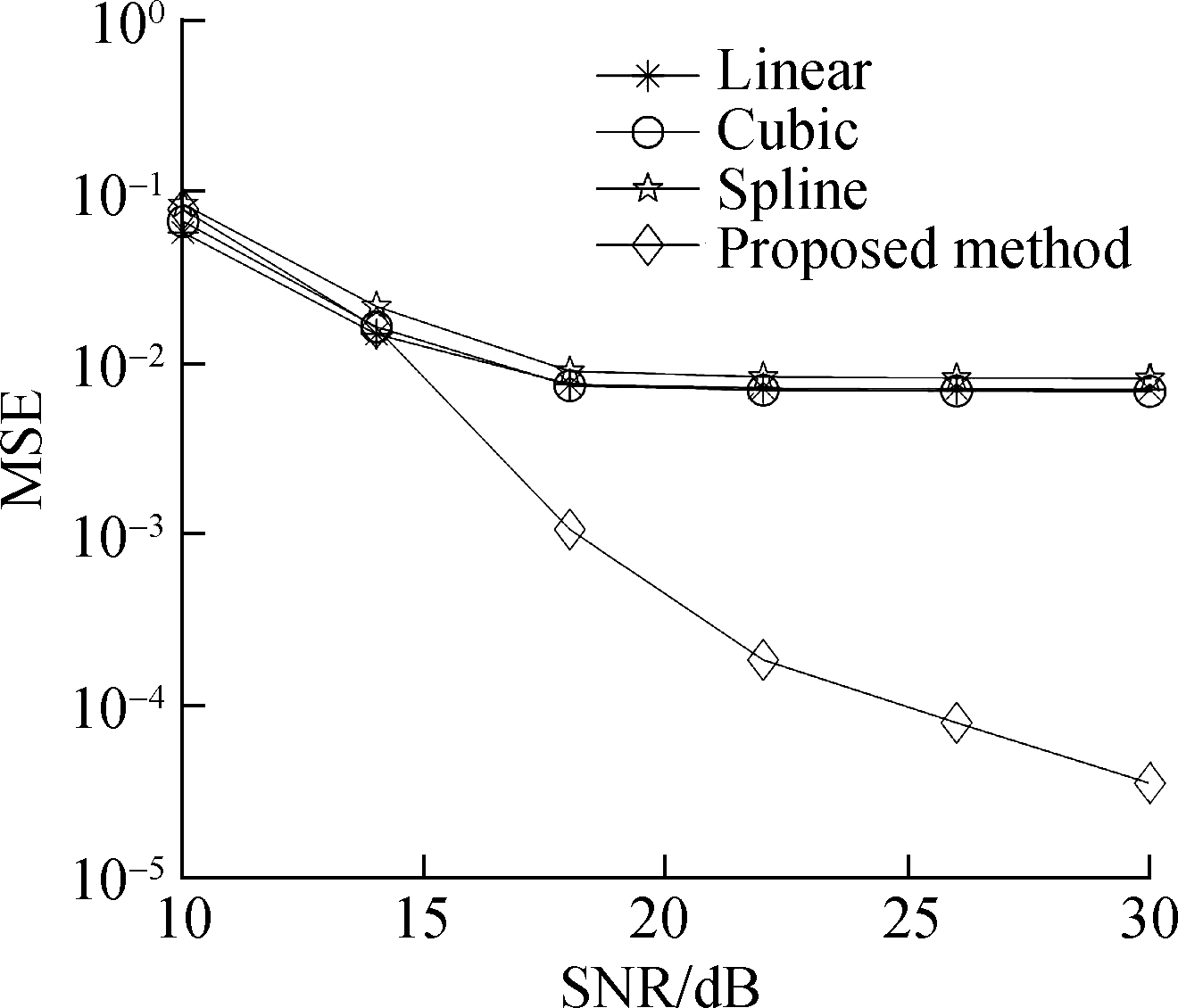
(b)
Fig.4 Comparing BER and MSE performance of linear, cubic, cubic spline interpolation methods and the proposed method against SNR (m=4). (a) BER; (b) MSE
It is obvious that
1) When the pilot spacing is small (m=3), the modified time domain interpolation outperforms linear interpolation and cubic interpolation in BER performance and has similar BER performance to cubic spline interpolation. Additionally, time domain interpolation is shown to be much better than other interpolation methods in MSE performance. The performance of linear interpolation is the worst.
2) When the pilot spacing is increased (m=4), the BER and MSE performance of cubic interpolation and cubic spline interpolation decrease rapidly, approaching linear interpolation, whereas the modified time domain interpolation method retains its good performance.
3.3 Comparison with time domain interpolation
When m=4, the time domain interpolation method meets the requirements for use. The legends “time domain interpolation, proposed method, and linear” denote LS channel estimation based on comb-type pilots with time domain interpolation, modified time domain interpolation, and linear interpolation in Fig. 5.
It is obvious that time domain interpolation and the proposed method provide comparable BER and MSE performance, which is significantly better than linear interpolation.
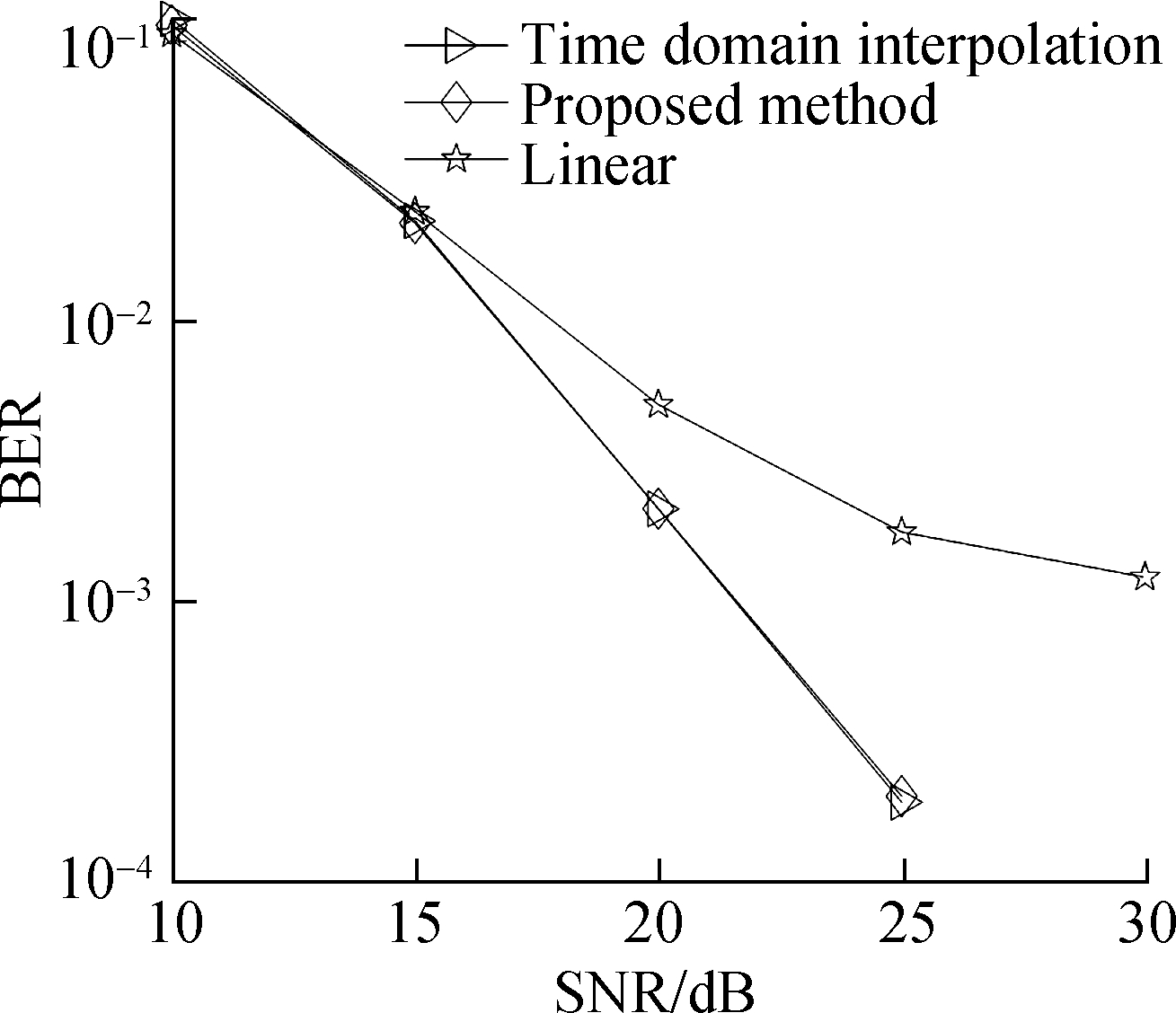
(a)

(b)
Fig.5 Comparing BER and MSE performance of time domain interpolation, linear interpolation, and the proposed method against SNR (m=4). (a) BER; (b) MSE
Time domain interpolation cannot be directly used when m=5 and m=6. The following methods are used to compare with the modified time domain interpolation.
Method 1 Perform K-point IDFT on the LS estimated CFR to obtain ![]() in the time domain, whose length is K, and extend it to an N-sample sequence by (N-K)-point zero-padding. Perform an N-point FFT on the obtained results to obtain the estimated CFR at all positions.
in the time domain, whose length is K, and extend it to an N-sample sequence by (N-K)-point zero-padding. Perform an N-point FFT on the obtained results to obtain the estimated CFR at all positions.
Method 2 Perform K-point IDFT on the LS estimated CFR to obtain ![]() in the time domain, whose length is K, and extend it to an mK-sample sequence by (mK-K)-point zero-padding. Perform mK-point DFT on the obtained result and take the previous N value as the estimated CFR of all positions.
in the time domain, whose length is K, and extend it to an mK-sample sequence by (mK-K)-point zero-padding. Perform mK-point DFT on the obtained result and take the previous N value as the estimated CFR of all positions.
The comparison between modified time domain interpolation, method 1, and method 2 is shown in Figs. 6 and 7. The legends “method 1, method 2, proposed method, linear” denote LS channel estimation based on comb-type pilots with method 1, method 2, the proposed method, and linear interpolation.
In the case of no noise, the CIR calculated by the modified time domain interpolation method (Eq.(26)) and the CIR calculated by performing K-point IDFT on the LS estimated CFR (Eq.(23)) are shown in Tabs. 1 and 2.
It can be seen that
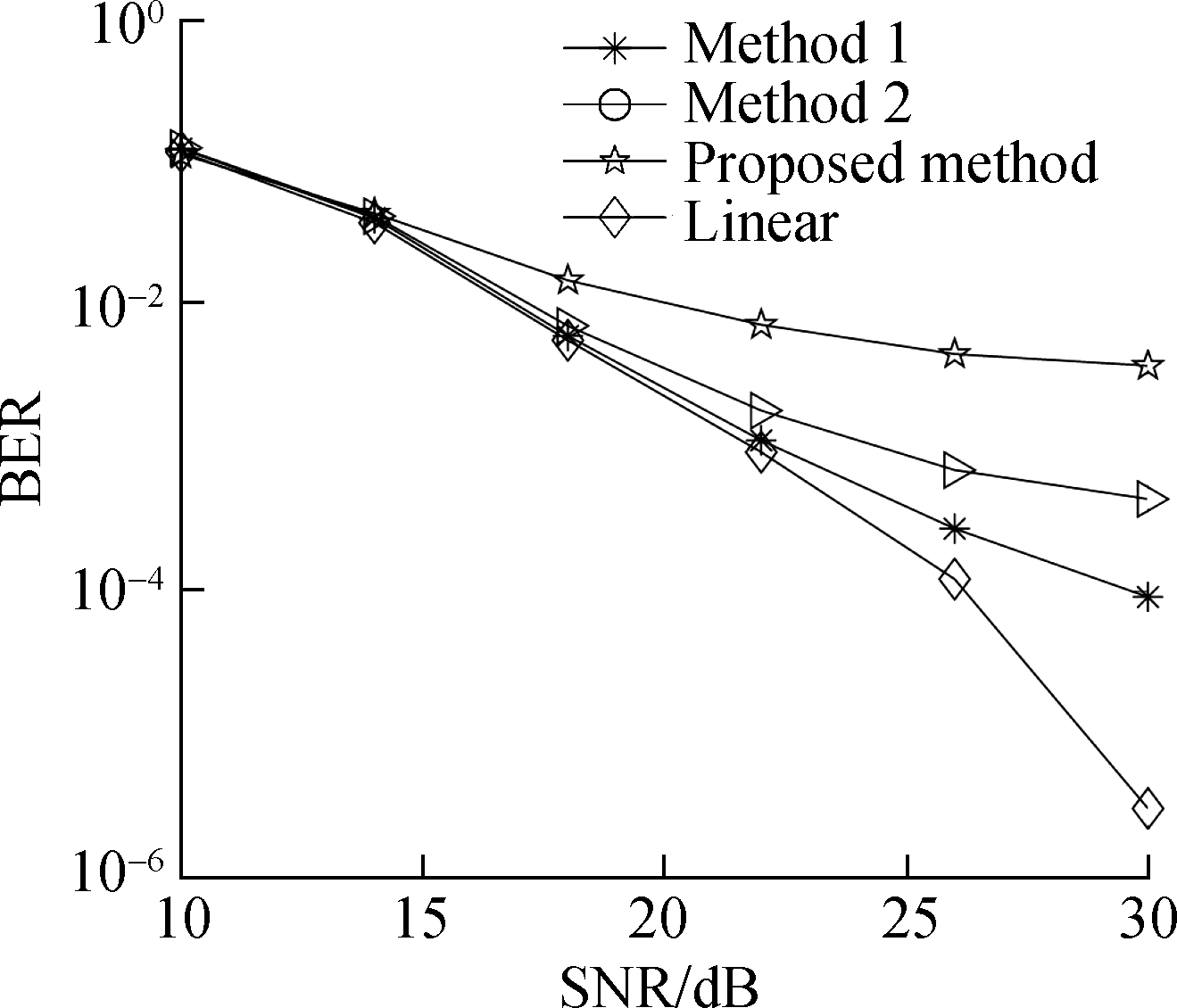
(a)

(b)
Fig.6 Comparing BER and MSE performance of linear interpolation, method 1, method 2, and the proposed method against SNR (m=5). (a) BER; (b) MSE
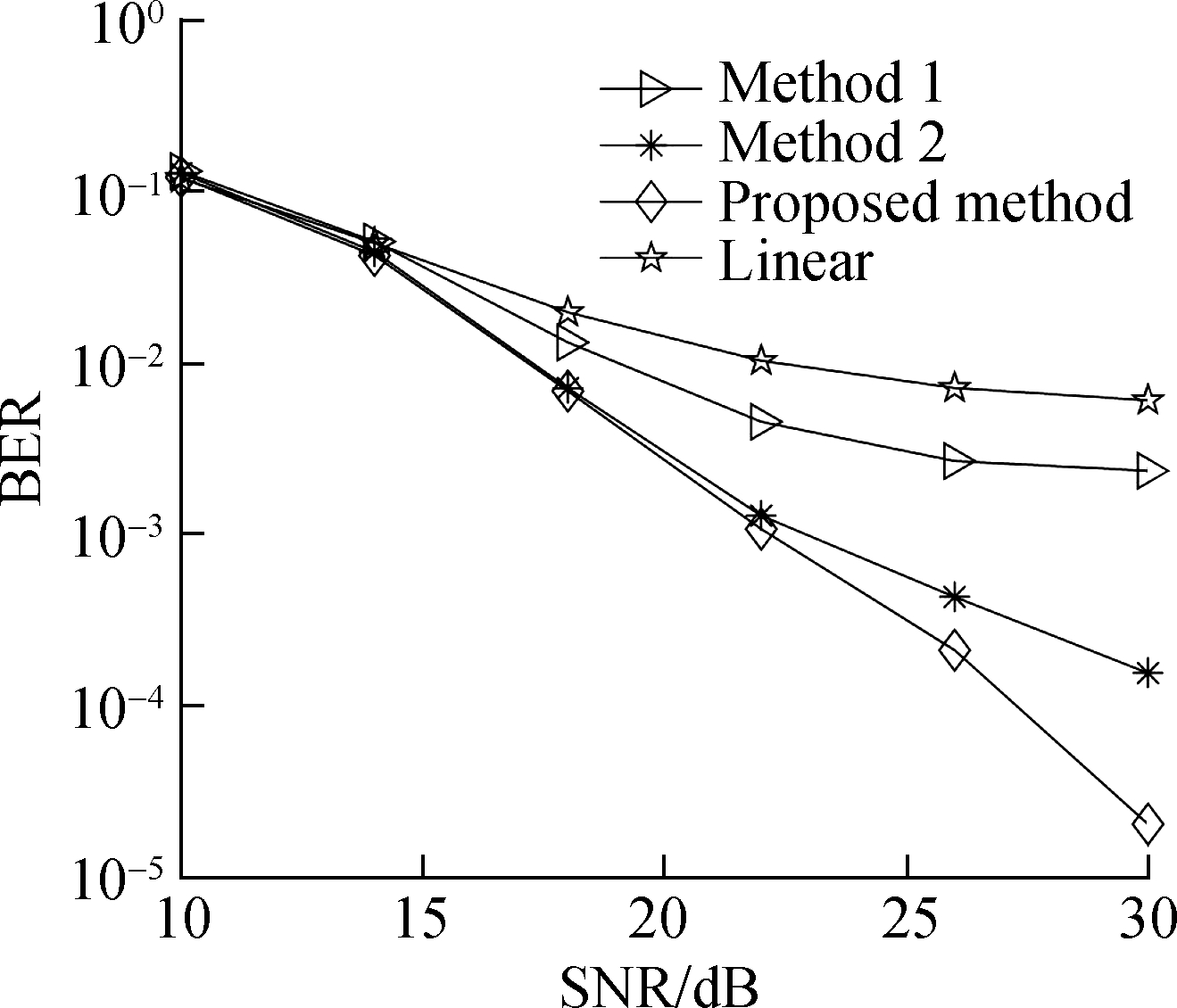
(a)

(b)
Fig.7 Comparing BER and MSE performance of linear interpolation, method 1, method 2, and the proposed method against SNR (m=6). (a) BER; (b) MSE
1)Methods 1 and 2 use K-point IDFT on the LS estimated CFR to calculate CIR; the amplitude of the estimated CIR is relatively accurate, but the phase error is significant and increases as index n increases.
2)Methods 1 and 2 outperform linear interpolation, but the mK-point DFT and K-point IDFT used do not meet the use conditions of the FFT algorithm (the number of FFT points must be a power of 2). Thus, the amount of calculation is very large. Methods 1 and 2 have low practical value and are only used as comparisons with the proposed method.
3) The modified time domain interpolation method outperforms methods 1 and 2 because it has similar calculation accuracy in the amplitude of the estimated CIR to methods 1 and 2, and the phase error is much smaller, as shown in Tabs. 1 and 2.
Tab. 1 CIR and the estimated CIR by the proposed method and IDFT (m=5)
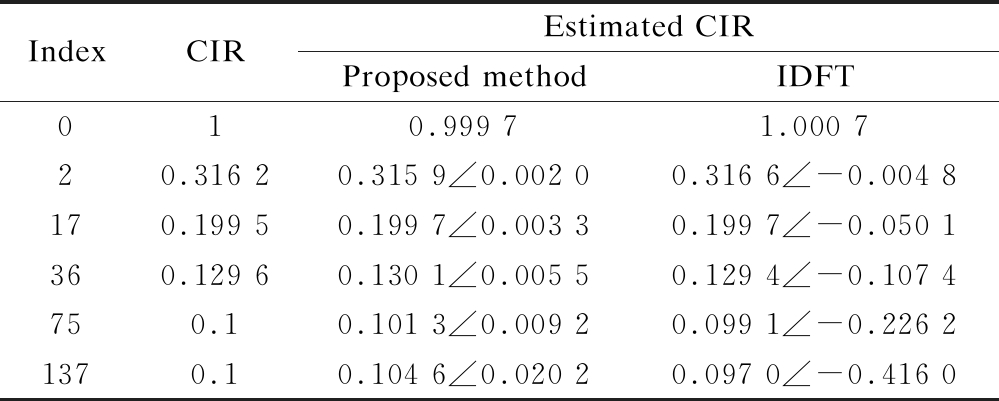
IndexCIREstimated CIRProposed methodIDFT010.999 71.000 720.316 20.315 9∠0.002 0 0.316 6∠-0.004 8170.199 50.199 7∠0.003 30.199 7∠-0.050 1360.129 60.130 1∠0.005 50.129 4∠-0.107 4750.10.101 3∠0.009 20.099 1∠-0.226 21370.10.104 6∠0.020 20.097 0∠-0.416 0
Tab. 2 CIR and the estimated CIR by the proposed method and IDFT (m=6)
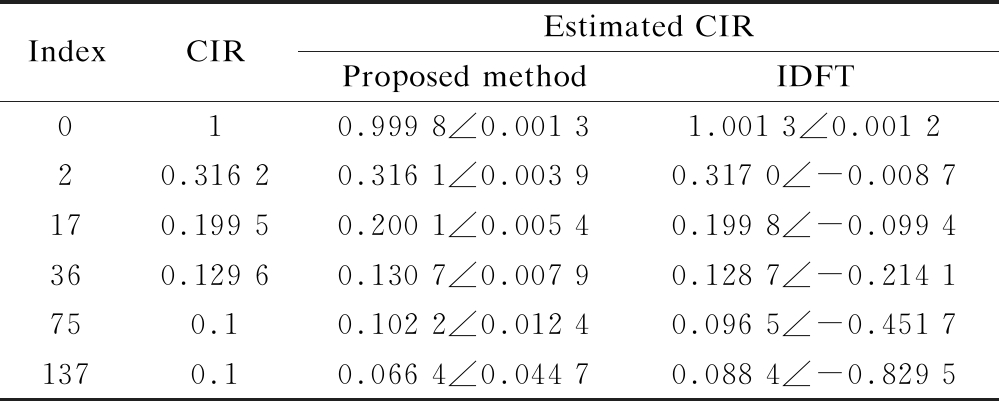
IndexCIREstimated CIRProposed methodIDFT010.999 8∠0.001 31.001 3∠0.001 220.316 20.316 1∠0.003 9 0.317 0∠-0.008 7170.199 50.200 1∠0.005 40.199 8∠-0.099 4360.129 60.130 7∠0.007 90.128 7∠-0.214 1750.10.102 2∠0.012 40.096 5∠-0.451 71370.10.066 4∠0.044 70.088 4∠-0.829 5
3.4 Computational complexity analysis
In practice, the reciprocals of PmK,m[n] can be stored, and division in Eq.(26) can be realized by multiplication. Using the proposed method, the computation amount includes three aspects: (N-K)-point linear interpolation, N-point IFFT, and Eq.(26). The computation amount for each step is shown in Tab. 3. (2N-K+(Nlog2N)/2) complex multiplications and (N-K+Nlog2N) complex additions are required. The proposed method has low computational complexity.
Tab. 3 Computation amount of the proposed method

Steps Complex multiplication Complex addition Linear2(N-K)N-K IFFT(Nlog2N)/2Nlog2N Eq.(26)K0
4 Conclusions
1) LS channel estimation based on linear interpolation is theoretically deduced, and the relationship between the estimated CIR from LS based on linear interpolation and the ideal CIR is analyzed.
2) The modified time domain interpolation method is proposed, which uses CIR obtained by LS based on linear interpolation to calculate actual CIR, and interpolation is realized by zero-padding in the time domain, such as time domain interpolation.
3) LS estimations based on comb-type pilots of different pilot spacings with the proposed method, time domain interpolation, and interpolation methods in the frequency domain, such as linear interpolation, cubic interpolation, and cubic spline interpolation, are simulated and compared. The simulation results indicate that the proposed method performs similarly to and outperforms time domain interpolation with low complexity.
4) The proposed method is exempt from the requirement that the number of subcarriers is an integral multiple of pilot spacing. The consumption of subcarriers used for channel estimation can be reduced.
[1] Telagam N, Sahu P C, Panda S, et al. USRP based digital audio broadcasting using OFDM in virtual and remote laboratory[J].International Journal of Online and Biomedical Engineering(IJOE), 2019, 15(13): 77-85. DOI:10.3991/ijoe.v15i13.8761.
[2] Jiang R, Wang X, Cao S, et al. Deep neural networks for channel estimation in underwater acoustic OFDM systems [J]. IEEE Access, 2019, 7: 23579-23594. DOI: 10.1109/ACCESS.2019.2899990.
[3] Honfoga A-C, Nguyen T T, Dossou M, et al. Application of FBMC to DVB-T2: A comparison vs classical OFDM transmissions[C]//Proceedings of the 2019 IEEE Global Conference on Signal and Information Processing (GlobalSIP). Ottawa, Canada, 2019: 1-5. DOI: 10.1109/GlobalSIP45357.2019.8969550.
[4] Pandya S, Wakchaure M A, Shankar R, et al. Analysis of NOMA-OFDM 5G wireless system using deep neural network[J].The Journal of Defense Modeling and Simulation: Applications, Methodology, Technology, 2021: 154851292199910. DOI:10.1177/1548512921999108.
[5] Sure P, Bhuma C M. A survey on OFDM channel estimation techniques based on denoising strategies[J].Engineering Science and Technology, an International Journal, 2017, 20(2): 629-636. DOI:10.1016/j.jestch.2016.09.011.
[6] Sutar M B, Patil V S. LS and MMSE estimation with different fading channels for OFDM system[C]//Proceedings of the 2017 International Conference of Electronics, Communication and Aerospace Technology (ICECA). Coimbatore, India, 2017: 740-745. DOI: 10.1109/ICECA.2017.8203641.
[7] Coleri S, Ergen M, Puri A, et al. Channel estimation techniques based on pilot arrangement in OFDM systems[J].IEEE Transactions on Broadcasting, 2002, 48(3): 223-229. DOI:10.1109/TBC.2002.804034.
[8] Jia L, Cao D Z, Hou C P. Two novel transform domain estimation methods for OFDM system and their application environment[C]//Canadian Conference on Electrical and Computer Engineering 2004. Niagara Falls, ON, Canada, 2004: 377-380. DOI:10.1109/CCECE.2004.1345034.
[9] Rocha C A, Mendes L L, Da Silveira A C. Performance analysis of channel estimation schemes for OFDM systems[C]//Proceedings of International Workshop on Telecommunications—IWT-2007. Santa Rita do Sapucaí, Brasil, 2007: 32-36.
[10] Li D, Guo F, Li G S, et al. Enhanced DFT interpolation-based channel estimation for OFDM systems with virtual subcarriers[C]//2006 IEEE 63rd Vehicular Technology Conference. Melbourne, Vic,Australia, 2006: 1580-1584. DOI:10.1109/VETECS.2006.1683112.
[11] Zheng K, Su J, Wang W B. DFT-based channel estimation in comb-type pilot-aided OFDM systems with virtual carriers[C]//2007 IEEE 18th International Symposium on Personal, Indoor and Mobile Radio Communications. Athens, Greece, 2007: 1-5. DOI:10.1109/PIMRC.2007.4394389.
[12] Zhang L, Hong Z H, Thibault L. Improved DFT-based channel estimation for OFDM systems with null subcarriers[C]//2009 IEEE 70th Vehicular Technology Conference Fall. Anchorage, AK, USA,2009: 1-5. DOI:10.1109/VETECF.2009.5378722.
[13] Jawhar Y A, Audah L, Taher M A, et al. A review of partial transmit sequence for PAPR reduction in the OFDM systems[J]. IEEE Access, 2019, 7: 18021-18041. DOI:10.1109/ACCESS.2019.2894527.
[14] Edfors O, Sandell M, van de Beek J-J, et al. Analysis of DFT-based channel estimators for OFDM [J]. Wireless Personal Communications, 2000, 12(1): 55-70. DOI: 10.1109/26.966074.
[15] Kang Y, Kim K, Park H. Efficient DFT-based channel estimation for OFDM systems on multipath channels[J].IET Communications, 2007, 1(2): 197-202. DOI:10.1049/iet-com: 20050337.
[16] Minn H, Bhargava V K. An investigation into time-domain approach for OFDM channel estimation[J].IEEE Transactions on Broadcasting, 2000, 46(4): 240-248. DOI:10.1109/11.898744.
[17] Murad M, Tasadduq I A, Otero P. Towards multicarrier waveforms beyond OFDM: Performance analysis of GFDM modulation for underwater acoustic channels[J].IEEE Access, 2020, 8: 222782-222799. DOI:10.1109/ACCESS.2020.3043718.
[18] Luo J F, Xie Z J, Xie M. Interpolated DFT algorithms with zero padding for classic windows[J].Mechanical Systems and Signal Processing, 2016, 70/71: 1011-1025. DOI:10.1016/j.ymssp.2015.09.045.
[19] Simeone O, Spagnolini U. Adaptive pilot pattern for OFDM systems[C]//2004 IEEE International Conference on Communications. Paris, France, 2004: 978-982. DOI:10.1109/ICC.2004.1312647.
[20] Jiang R K, Wang X T, Cao S, et al. Joint compressed sensing and enhanced whale optimization algorithm for pilot allocation in underwater acoustic OFDM systems[J].IEEE Access, 2019, 7: 95779-95796. DOI:10.1109/ACCESS.2019.2929305.
[21] Qiao G, Babar Z, Ma L, et al. MIMO-OFDM underwater acoustic communication systems—A review[J].Physical Communication, 2017, 23: 56-64. DOI:10.1016/j.phycom.2017.02.007.
[22] Barnett A H, Magland J, af Klinteberg L. A parallel nonuniform fast Fourier transform library based on an “exponential of semicircle"kernel[J].SIAM Journal on Scientific Computing, 2019, 41(5): C479-C504. DOI:10.1137/18m120885x.
[23] Zhao Y P, Huang A P. A novel channel estimation method for OFDM mobile communication systems based on pilot signals and transform-domain processing[C]//1997 IEEE 47th Vehicular Technology Conference on Technology in Motion. Phoenix, AZ, USA, 1997: 2089-2093. DOI:10.1109/VETEC.1997.605966.
[24] Fan T L, Wen Y C, Huang S B, et al. An improved DFT-based channel estimation algorithm for OFDM system in non-sample-spaced multipath channels[J].Circuits, Systems, and Signal Processing, 2014, 33(4): 1277-1288. DOI:10.1007/s00034-013-9678-0.